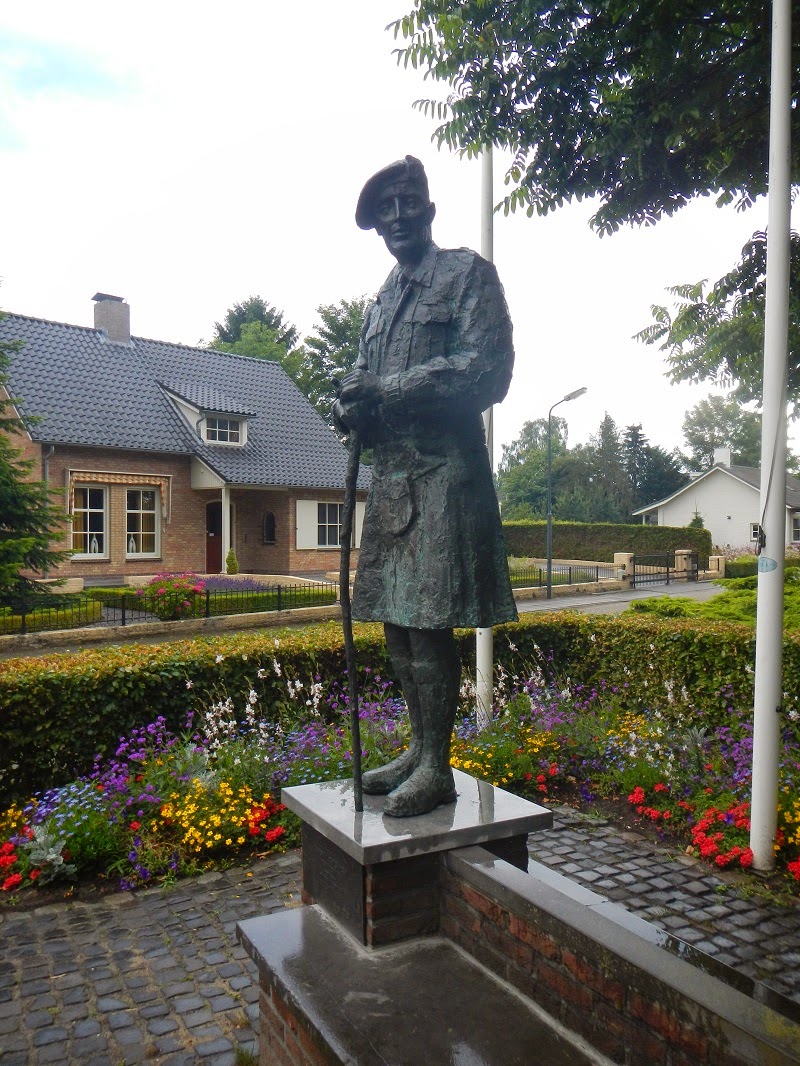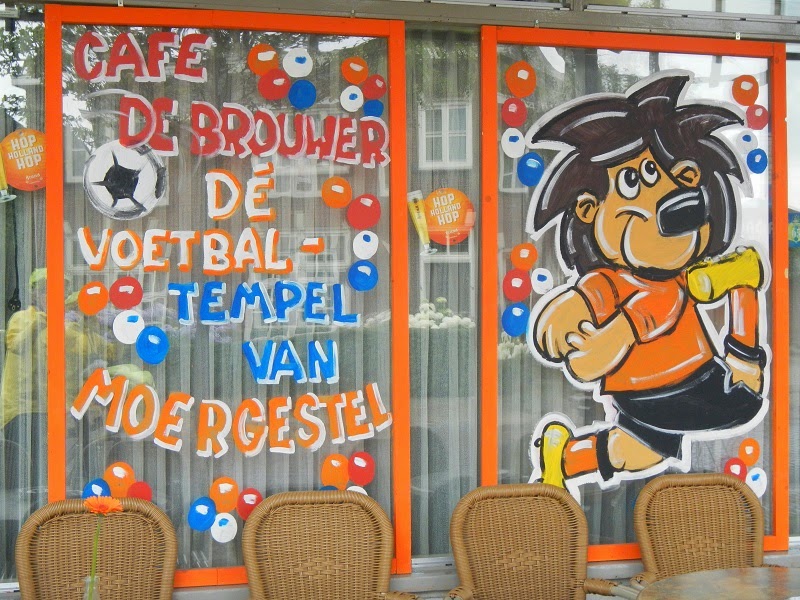The sky looked like it might send down some rain soon but I thought I would keep cycling so that I might reach a town.
 |
| This monument is in Moergestel which was liberated on Oct. 25th, 1944 by the 15th Scottish Division. The statue is a reproduction of the division General Major Colin M. Barber. General Barber was the tallest man in the British Army. |
 |
| Knooppunten sign for bicyclists and hikers |
 |
| As I came into Moergestel, the sky that had been pretty dark, opened up and a torrent of rain came down...BUT I just happened to be by a bus stop and moved Silver and myself inside where it was nice and dry until the shower was over. |
 |
| Sint Janskerk |
 |
| Moergestel is in the municipality of Oisterwijk and is about 7 km. east of Tilburg. |
 |
| Dutch football (soccer) fever is very alive here! |
 |
| "Cafe De Brouwer is the soccer temple of Moergestel" |
 |
| "Our soccer----our beer" |
 |
| De Koningshoeven Brewery (Brouwerij de Koningshoeven) is a Dutch Trappist brewery founded in 1884 within the walls of the abbey Onze Lieve Vrouw van Koningshoeven in Berkel- Enschot near Tilburg. They founded the brewery to finance the monastery and contribute to charitable causes. Today the monks of the abbey are the ultimate authority on the brewing process but a secular company, Bavaria Brewery, runs the business operations. |
 |
| Tilburg--You are here! Tilburg is a landlocked city in Noord- Brabant. The population of the area is 210,289. It is the 2nd largest city of Noord-Brabant and the 6 th largest in the Netherlands. The name "Tilburg" first appeared in documents back in 709 AD.In the 14th century, Tilburg was declared a manor. In the 15th century Tilburg Castle was built and although it was later torn down for a factory, a replica of the foundations of the castle was restored in 1995. Tilburg grew around "herd places", triangular plots where a number of roads (usually sand roads) met. These herd places were pasturelands for flocks of sheep. The farmers raised sheep for wool and wove it themselves on their looms. In 1881, Tilburg had as many as 145 woollen mills. In the 1960's the industry collapsed and by 1980 there were only less than 5 left. Today Tilburg industry consists of a wide variety of enterprises. |
 |
| A high rise building |
 |
| Bosscheweg Bridge--Bosscheweg is a highway coing toward Tilburg from Oisterwijk |
 |
| King William II (1792-1849) Statue in Tilburg--King William always bore a warm heart towards Tilburg. "Here I can breayhe freely and I feel happy" he once said about the town. He provided money to improve the sheep breeding and built new farms. In 1847 he commissioned the construction of a palace here that would be his country home. It is now part of Tilburg City Hall. |
 |
| St. Jozefkerk (Heuvelse kerk)--The Heuvelse Church or St. Joseph Church is a catholic Gothic Revival church in Tilburg. It was built between 1872 and 1889. It has two 72 meter high octagonal towers. |
 |
| New construction marked by orange national soccer pride decorations |
 |
| Statues along the street----- |
 |
| ...on both sides of the bus stop on Bredaseweg. |
 |
| I thought this was maybe a seminary but cannot find proof. |
 |
| Since 1897, Tilburg has proudly possessed a water tower that still supplies the cleanest spring water in the Netherlands. The construction of the water tower was a positive development for the textile industry as well as public health, as the quality of city water improved drastically. The tower is 50 meters high and built of brick. The entrance is characterized by a frame decorated in a neo-Renaissance style. The tower remained intact during WWII because the Germans used it to gain healthy drinking water and also as a watchtower over Tilburg. Unfortunately, it was damaged when the Nazis were driven out of Tilburg. |






















No comments:
Post a Comment